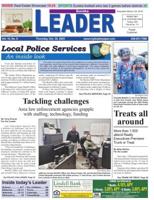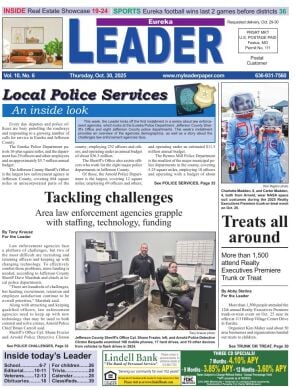State and federal agencies are prepared to spend $22 million to remediate sections of the Big River watershed as part of a larger effort to protect the natural habitat, landowners and the public from lead exposure.
The U.S. Fish and Wildlife Service, along with the Missouri Department of Natural Resources, recently held a meeting to share its draft restoration plan with the public. The meeting was held on June 26 at the High Ridge Fire Protection District Station 1.
The plan includes six proposed alternatives for lead remediation, ranging from alternative A, doing nothing to prevent further lead contamination and stream bank erosion, to alternative F, completing most of the proposed options in a holistic approach to restoration, which is the option state and federal agencies prefer, according to the plan documents.
Fish and Wildlife biologist Leslie Lueckenhoff said about 25 people attended the meeting, where representatives explained the alternatives, asking questions about the proposed options and how they might affect nearby properties.
The proposed restoration plan is a response to the discovery of high levels of hazardous materials found in the watershed from mining-associated facilities, such as mines, mills, smelters and tailings impoundments.
Parts of Jefferson County are included in the Old Lead Belt of southeast Missouri, known at one point as the leading producer of lead in the world, Lueckenhoff said. St. Francois, Washington, Madison, Crawford, Iron, Dent, Reynolds and Shannon counties also are included in the lead belt.
“The impacts to this stream have been going on since the 1800s,” Lueckenhoff said. “There’s a great legacy of mining in the area, but there’s also widespread contamination from heavy metals, specifically within the river. You can’t just go and create the Big River elsewhere, right? It’s this unique, amazing resource that we want to restore for the public’s benefit.”
The 33-page plan can be accessed by visiting the U.S. Fish and Wildlife Service website, fws.gov, and typing “Draft Restoration Plan and Environmental Assessment for the Big River Stream and Riparian Habitat Restoration” in the search bar. The Missouri Department of Natural Resources website, dnr.mo.gov, has the same information.
Lueckhenhoff said her agency will accept feedback on the proposed plan through Saturday, July 19. Comments may be sent to her email, leslie_lueckenhoff@fws.gov, or to her mailing address, 101 Park DeVille Dr., Suite A, Columbia, 65203.
Once all comments are reviewed, a final plan will be released to the public on the U.S. Fish and Wildlife Service website.
Lueckenhoff said her agency will contact landowners immediately to begin restoration efforts, stressing that landowners’ participation is “100 percent voluntary.”
“We’re looking to work with landowners who are potentially losing ground because of erosion issues,” she said. “We’re looking at trying to improve the habitat. It would be largely beneficial to all the landowners and the people who want to recreate in the river.”
Alternatives
The funding for the restoration project comes from the American Smelting and Refining Co. (ASARCO) bankruptcy settlement agreement, approved in 2008 to clean up approximately 10.5 million cubic yards of contaminated soil in 26 sites across the United States.
Lueckenhoff said all the “suite of alternatives” proposed in the draft plan are designed to restore the environment and compensate the public and landowners for any injuries to natural resources due to the release of heavy metals into the river.
Alternative B in the draft plan focuses on river mile 31, near Morse Mill in the southern portion of the county. This option would include stream bank stabilization in the area, along with forest restoration, Lueckenhoff said.
Alternative C focuses on the dam at Rockford Park in House Springs.
Lueckenhoff said this option might include the modification or full removal of the dam to provide “a more natural hydraulic state of the river at that location.”
“That project would serve both an ecological benefit, which, for us, includes protecting things like freshwater mussels and crayfish, but would also have the benefits of reducing the risks to public safety that are obviously apparent at the site.”
Rockford Park has been the site of drownings for at least a decade, with six drownings occurring since 2014, because people tend to misjudge the strength of the Big River’s current at the park’s access point, according to officials.
Alternative D focuses on bank stabilization and riparian restoration in the lower 30 miles of the Big River in Jefferson County. The option includes, but is not limited to, approximately 350 acres of revegetation, 350 acres of land protection through conservation easements and bed sediment collection through gravel bar excavation, according to the plan.
Alternative E would include stabilizing eroding streambanks on the Meramec River near the mouth of the Big River near the Jefferson County portion of Eureka. The project would include revegetating 20 acres along the river and conservation easements.
Lueckenhoff said her agency proposes completing alternatives B through D, called alternative F, for the public. According to the draft plan, alternative F is a more all-encompassing approach to habitat restoration and stream stabilization than just doing any of the other alternatives individually.
“We’re looking to take a comprehensive approach to restoration throughout the Big River,” Lueckenhoff said. “We want to do good work, and we want to be a partner. We’re hoping to do some good things that can really help benefit the resources and benefit the public.”




